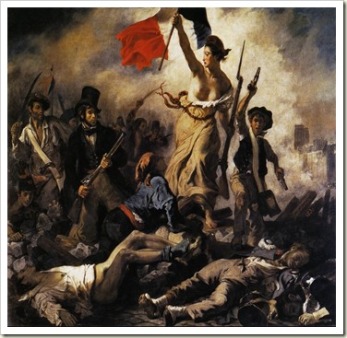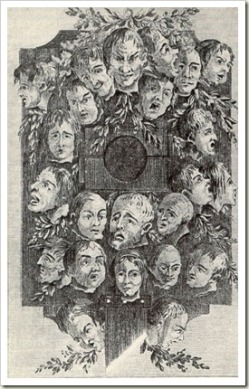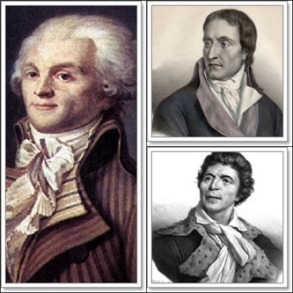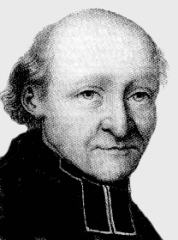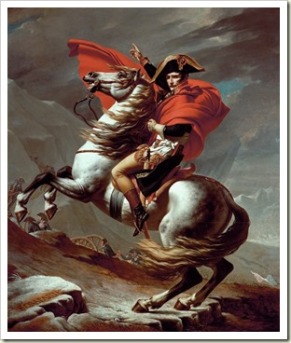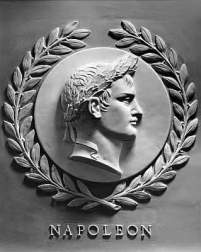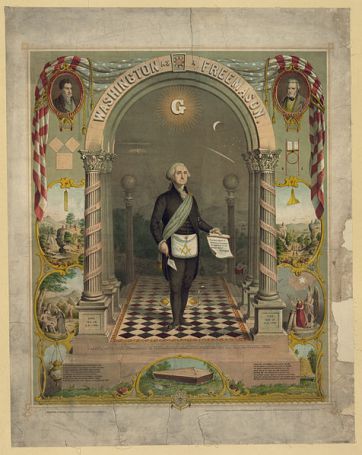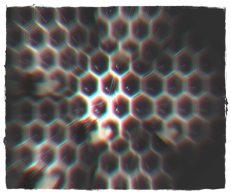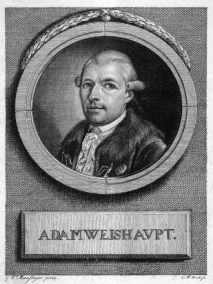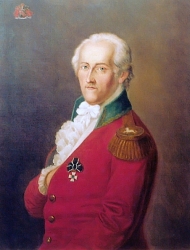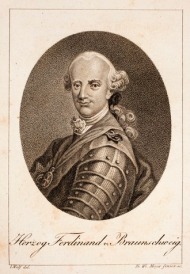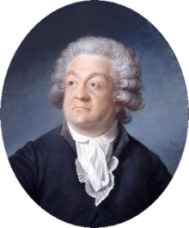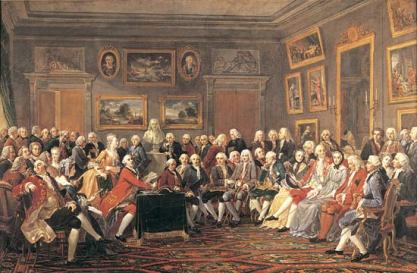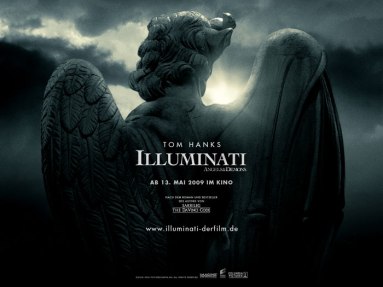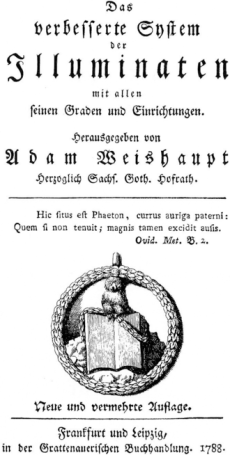“Deluded people. You must understand that there exists a conspiracy in favor of despotism, and against liberty, of incapacity against talent, of vice against virtue, or ignorance against light! … Every species of error which afflicts the earth, every half-baked idea, every invention serves to fit the doctrines of the Illuminati …The aim is universal domination.”
– Marquis de Luchet Essay on the Sect of the Illuminati January, 1789.
The Marquis De Luchet was initially in favour of the French Revolution until presumably joined the dots regarding his friend the Comte de Mirabeau and realised all was not well. He wasn’t the only one who thought the Revolution had been hijacked away from genuine grassroots uprising. Discerning politicians in America and Britain were also sounding the alarm, but these were lone voices in a sea of romantic resolve. The Irish philosopher and Member of Parliament Edmund Burke * issued stern warnings during the onset of the Revolution and incurred the wrath of the public and many of his colleagues as a result.
Burke was an expert on change. He knew intuitively that radical change, too swift and sweeping, frequently led to the very same dynamics of tyranny. While he had given his support to the American Revolution, the causes of which in his opinion, were of an entirely different nature, he felt it duty bound to resist supporting the French people for reasons that will be become apparent.
Much like the media of today, hit pieces appeared in the press which were controlled by Illuminati agents hiding behind the cover of liberal sentiments. Suddenly, Burke’s once popular standing was swiftly reduced to rubble after his publication of Reflections on the Revolution in France (1790). The treatise is now widely seen as the statesman’s defining moment for its erudition, prescience and wisdom. It consisted of a correspondence with “a Paris gentleman” a French aristocrat named Charles-Jean-François Depont who had asked Burke for his impressions of the Revolution. This resulted in two letters, the latter of which became Reflections.
As a protestant and a Whig, his conservatism was just and represented the benevolent aspect of a capitalism that grew into something quite different in this century. Liberty and power were entwined and represented a force for good or for ill depending on who was at the helm. A cardinal rule for Burke and for those of us paying attention to politics subsequently, is to recognise: “… in situations where those who appear the most stirring in the scene may possibly not be the real movers.” [1] Early on in the midst of Revolution euphoria he saw the much trumpeted “liberty” as counterfeit and cautioned people to see the Revolution for what it was – a carefully engineered coup against certain sections of society. (Such a plea for caution was levelled by many observers at the onset of Barack Obama’s election both in terms of the scale of expenditure involved and the “yes we can” Obamamania marketing which ensued. Obviously, not much has changed.
Burke wrote:
When I see the spirit of liberty in action, I see a strong principle at work; and this, for a while, is all I can possibly know of it. The wild gas, the fixed air, is plainly broke loose; but we ought to suspend our judgment until the first effervescence is a little subsided, till the liquor is cleared, and until we see something deeper than the agitation of a troubled and frothy surface. I must be tolerably sure, before I venture publicly to congratulate men upon a blessing, that they have really received one.
Flattery corrupts both the receiver and the giver, and adulation is not of more service to the people than to kings. I should, therefore, suspend my congratulations on the new liberty of France until I was informed how it had been combined with government, with public force, with the discipline and obedience of armies, with the collection of an effective and well-distributed revenue, with morality and religion, with the solidity of property, with peace and order, with civil and social manners. All these (in their way) are good things, too, and without them liberty is not a benefit whilst it lasts, and is not likely to continue long. [2] [Emphasis mine]
And he was right.
Liberty Leading The People, Eugene Delacroix, 1830, Paris, Louvre
Burke was also acutely aware of the significance of the French Revolution that could remake Europe and even the world under tyrannical lines: “It appears to me as if I were in a great crisis, not of the affairs of France alone, but of all Europe, perhaps of more than Europe.” He was fully cognizant of the nature of the usurpers of power that were inspired by such thinkers as Rousseau and Voltaire who were avowed rationalists and believers in a ruling Elite – the forerunners a Hegelian World Order. Many of the the Age of Reason and the Enlightenment pioneers represented dangerous abstractions to traditionalists like Burke who knew that society was a complex organism that did not operate on simplistic laws which benefited a ruling class grounded in man’s power rather than God’s. He had no time for those who believed in authoritarian rule whether a divinely appointed monarchic Establishment or an Elite ruling class. Similarly, if a government was oppressive then the people should oppose it, therefore, rather than open revolution he preferred gradual constitutional reform.
Burke was well aware of the Order of Illuminati often referring to them as the “Philosophe sect” in many of his writings. He criticised the Enlightenment’s “social contract” which was a socio-political theory based on Goethe’s Faustian pact. One has to have consented, either explicitly or tacitly, to give up one’s freedoms in exchange for what little rights may be left even though they may have been slowly eroded down to nothing, a process playing out in the West today, particularly in Britain and the United States. This surrendering to authority may be a Presidential court of law or the consensus of a majority. Either way, it is a backdoor to tyranny which is exactly why the Illuminati promoted this line of thinking.
The social contract was very much en vogue at the time. Burke granted credence to the idea that society is a contract: “But it is not a partnership in things subservient only to the gross animal existence of a temporary and perishable nature” rather, it is: “a partnership not only between those who are living, but between those who are living, those who are dead, and those who are to be born.” He makes a pointed reference to the cold, rationalism of the Illuminists and the beliefs of materialism, deism and atheism that they were encouraging. He makes a case for the complexities of history and the links that humans created over time with a rich tapestry of social values which cannot be suddenly erased in favour of something perceived as socially responsible and harmonious, least of all by a sect which represented the “public” image of a far greater threat than even these lone voices realised.
Burke’s views also differed from Thomas Hobbes’ theory which effectively saw man and women as numbers on an economic chart to move around at will presaging the game theorists of later years. And here one can see why the Irish philosopher was so fiercely ridiculed on orders of Illuminists: he was the polar opposite of their ideals and precisely what was needed in large numbers to counter their plans.
***
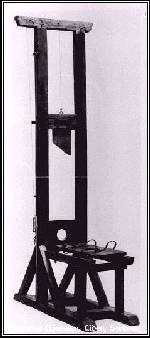 “The Reign of Terror” commenced from 1793 until 1794 under the dictatorship of Maximilien Robespierre and the Jacobin mob. There is a general consensus from past statistics of the Terror, the causes of which came from the Orwellian-sounding Committee of Public Safety and The Revolutionary Tribunal and which stood at approximately 16,000 and 41,000 deaths. Historian Dr Marisa Linton of the Faculty of Arts and Social Sciences at Kingston University quoted a figure of 16,594 death sentences and a total which excluded those “… that died without formal death sentences imposed in a court of law.” And further: “Many perished in overcrowded and unsanitary prisons while awaiting trial. Many of those who died in the civil wars and federalist revolts did not have their deaths officially recorded.” [3]
“The Reign of Terror” commenced from 1793 until 1794 under the dictatorship of Maximilien Robespierre and the Jacobin mob. There is a general consensus from past statistics of the Terror, the causes of which came from the Orwellian-sounding Committee of Public Safety and The Revolutionary Tribunal and which stood at approximately 16,000 and 41,000 deaths. Historian Dr Marisa Linton of the Faculty of Arts and Social Sciences at Kingston University quoted a figure of 16,594 death sentences and a total which excluded those “… that died without formal death sentences imposed in a court of law.” And further: “Many perished in overcrowded and unsanitary prisons while awaiting trial. Many of those who died in the civil wars and federalist revolts did not have their deaths officially recorded.” [3]
However, Linton continues:
“… recent estimates of the number of deaths in the Vendée have caused historians to revise that figure considerably. One historian, Pierre Chaunu, spoke of the Vendée with deliberate provocation as a ‘genocide’ and claimed that 500,000 rebels had died. More realistic estimates, such as that by Jean-Clément Martin, suggest up to 250,000 insurgents and 200,000 republicans met their deaths in a war in which both sides suffered appalling atrocities. Another group that was decimated by the unleashing of the Terror was that of the revolutionaries themselves. Successive revolutionary factions fell victim to the Terror that, in many cases, they had themselves helped to orchestrate.” [4]
Apart from other methods of execution such as hanging, firing squad and even drowning, the gruesome, mechanical evil of the guillotine sliced through the necks of anyone who disagreed with the Revolution. It was the manner in which this “social uprising” was conducted which cast a dark stain across its avowed principles. Many victims were also set upon and murdered by death squads which roamed the cities of France often as out-sourced mercenaries. As a microcosm of the Spanish Inquisition, the Nazi holocaust, the English Witch-hunts or Stalinist rule, Revolutionary France was not a place to be for any true progressive, peasant or aristocrat. Many were murdered through rumour, accusation or the denouncement of a business competitor or creditor even if entirely innocent.[5]
Of the thousands to be condemned to the guillotine 8 percent (1031) were aristocrats, 6 percent (674) clergy, 14 percent (2923) middle class, and a whopping 72 percent (7878) were workers or peasants accused of hoarding, evading the draft, desertion or rebellion.[6] This tells you something important about the nature of the “People’s Revolution” in itself, namely, it was a text book example of despotic rule.
The Committee for Public Safety – a classic example of paramoralistic wording – allowed revolutionary tribunals to convict people without hearing evidence and which was called the Law of Prairial. In September 1793, the Convention passed a law called the Law of Suspects where the “public safety” actually meant people could now be put in prison without trial: “Suspects shall be locked up …. The proof necessary to convict enemies … can be any kind of evidence … If proof already exists there need be no further witnesses …The penalty for all offences under the law of revolutionary tribunal is death.” [7] It didn’t really matter who you were or what you did, once in the mouth of the machine there was little anyone could do. Very often French folk were condemned to death and executed the same day.
The following examples indicate the arbitrary nature of accusations which resulted in death:
Jean-Baptiste Henry, aged 18, journeyman tailor, convicted of having sawn down a tree of liberty, executed 6th September, 1793.
Francois Bertrand, aged 37, publican, convicted of having provided the defenders of the country with sour wine, condemned and executed the same day.
Henriette Francoise Marboeuf, aged 55, convicted of having hoped for the arrival of the Austrians and Prussians and of keeping food for them, condemned to death and executed the same day. [8]
As the terror came to gradual end in July 1794, revolutionary surveillance committees (Comité de surveillance révolutionnaire) with oversight by district committees continued the formula of repression for many years after.
There is ample evidence to suggest the eradication of counter-revolutionaries was part of a larger policy of depopulating France of “enemies of the people” which meant everyone who was not of the same mind. Author Nesta Webster suggested that the almost unimaginable slaughter of hundreds of thousands of French citizens during the Terror was indeed a deliberate campaign of genocide, an 18th Century example of an Elite belief which is so prominent and popular in political, academic and UN-led institutions today. Though conceived as part of the Committee’s plan, it has the classic hallmarks of the occult Establishment clique and so many World State believers: in order to return to an Eden ruled by a superior class of demi-Gods or Olympians a periodic culling of the rabble was necessary by whatever means available at the time.
As Steve Bonta describes in his article on effectively “Two Revolutions”:
The mad Marat, for whatever reason, had an idee fixe that demanded the massacre of 260,000 victims. But his blood lust was soon surpassed by his depraved “democratic” confreres. Jean Bon St. Andre averred that France’s population of 25 million “must be reduced by more than half.” Collot d’Herbois declared it must be reduced to 10 million. Carrier insisted only 6 million should survive. Guffoy said 5 million, whilst Robespierre is reported to have said that a population of 2 million would be more than enough. “Let us make a cemetery of France rather than not regenerate her after our manner,” declared Carrier. He and his confederates proceeded to do just that. After their abominable massacres in La Verdee, the revolutionists proudly reported back to the Convention in Paris, “we have left nothing behind us but ashes and piles of corpses.” All of this a century and a half before the likes of Stalin, Hitler, Mao, Pol Pot, and other 20th-century genocidal dictators made mass extermination a jaded political cliché. [9]
Bonta shows us that the reality of an Age of Enlightenment was in fact a quality of “illumination” which set alight only certain aspects of human endeavour in the modern age. Moreover, it’s rapid descent into destruction showed it’s shadow side in dramatic fashion. It was: “… a Revolution that began with a proud rejection of Deity, and worship of the State, turned into a hideous, blood-soaked parody of civilization, where technology and reason were applied to mass murder in the name of enlightened social engineering.” This set the stage for a fractal replication within a Western geo-political context.
Indeed, does this not describe the United States and NATO expansionism of the last fifty years?
Once again, the Jacobin Club was host to a surfeit of brutal psychopaths more than willing to take on the blood-letting. Sensing predation in the air, sniffing out victims with a super-natural instinct, another pattern of unrelenting horror was st in motion, allowing their true selves to manifest with impunity since their actions were fully mandated by the authorities. Sadistic individuals like Jean Paul Marat and his army of “Marats” or “Mulattos” were at the forefront of this mass murder, a logical result of authoritarian followers and essential psychopaths being given – quite literally – a free Reign. Marat was only among a number of anti-human individuals who undertook their tasks with extraordinary relish and were deemed useful for suppressing dissent and revolt against the Convention. Massacres and mass executions began to appear on a scale that harked back to the decimation of Cathar credents by the Inquisition in Languedoc.
Of particular note was one Jean-Baptiste Carrier who became notorious for for creating a variety of horrific ways for victims to be put to death. One method which he favoured on more than one occasion was to cram large numbers of people into boats with trap doors in the floors which he ordered sent out into the Loire to be sunk. This manner of mass death was frequently employed against the clergy whom he hated with a passion and in one instance exclaimed: “I have never laughed so much as when I saw the grimaces those priests made as they died.” So many bodies were floating in the rivers of France that it became a health problem and drinking was prohibited.
Hundreds of prisoners were also lined up in fields and summarily shot by the National Guard; anti-revolutionaries – which sometimes numbered many hundreds – were mown down by fusillades and whole cities ransacked; children were clubbed, run through with sabres and shot en masse, a particular activity close to Carrier’s heart.
Perhaps no other city suffered as much as Nantes. It was almost entirely emptied of people who were then starved in its prisons, shot to death, guillotined and cut down in their homes on orders of Carrier and his minions. Special drains were installed in the Place de la Revolution in Paris to cope with the torrents of blood from the guillotine.
As various strains of anti-social pathologies take hold and subsequently elevated to positions of influence over ordinary men and women, large-scale psychological trauma and /or genocide on a macro-social scale is the inevitable result. Sophisticated ideals and morals are swiftly torn away and discarded like confetti, rapidly overtaken by the true purpose of a Revolution of this nature: political strategy thought up and carried out with psychopathic brutality. “The end justifies the means” is the mantra of the Elite Pathocrat where all is permitted for the cause of rending flesh from the the conscience of the normal psyche.
The parallels of pathology between the “Reign of Terror” and the “Red Terror” and even the evolution of the “War on Terror” appear to come from the same source. Just as Carrier enrolled companies of criminals or “mulattos”, the same dynamics were followed by Leninists troops as they were formed during the Communistic Terror in Hungary and by agent Trotsky who created terrorist troops as well as the Chinese gangs in Russia. Russian writer Alexsi Kuprin, questioned how it was possible that such a: “… bilious and dyspeptic chemist, anarchist, spy and plotter, whose speeches are full of such phrases as ‘roast on a slow fire’, ‘strangle’, ‘inundate with blood’, ‘cut off their heads’, should be seized by a blind fate and placed in the seat of power, instead of ending his days as a ‘sadist’ in a ward for violent lunatics?” [10]
In societies dominated by a rising tide of Pathocracy such people become valued political tools who find their natural place within the various tributaries of pathology, cloaking themselves in differing garbs of beliefs and ideals.
As writer George Rivers-Pitt states:
“Robespierre and Marat, like their ardent admirers, Lenin and AS at the present day, were animated by the same noble vision, not to relieve present distress and injustice by legislation, but only to annihilate all existing conditions, and “to exterminate all classes of the community except ‘the people’ over whom they hoped to rule supreme”. […] In their vision of the ‘New Birth of Society’, it is the blood of the Caesarean section they hope to practise on the expiring mother society, not the fate of the offspring which is their chief concern. […]Now that the terrorist period appears to have burned itself out to a very great extent in Russia, it is well that we should realise that it was an essential and deliberately designed phase of the Bolshevik plan, and that, as it was manifested with the same maniacal ferocity, wholesale butchery and bestiality, in Hungary, so would it be an inevitable prelude to any successful attempt to establish the same regime in any other European country. Mob licence and destruction would be encouraged and tolerated only as a means to preparing the way for the new dictators and for placing them in power.” [11]
The vast upsurge of revolutionary ideas which led to the Great Terror needed anti-human individuals to facilitate a framework of control whereby such unbridled desires could be exercised against the populations without resistance and where sadism manifested across the whole psychopathic spectrum. This is essentially what systematic and organised atrocity means for those who perpetrate such deeds – a pleasure that matches sexual gratification. In the sacking and plunder of Toulouse in South-Western France, 19th century author of semi-fictional Cathar accounts Maurice Magre intuited such a contagion that stimulates and appeals to the lowest instincts in man and a natural state of psychopathy when the right conditions are in place:
“I had always believed that the affinity for theft and the desire for riches were at the roots of war. I realised that they were futile. The procession of women is the propelling force that pushes men to fight. The only thing the soldiers were talking about was the beautiful women they were going to take from the conquered cities … something akin to a sexual hallucination raged like a ghost in the back of everyone’s gaze.” [12]
The ceremonial psychopathy of Illuminism permitted such ponerological influences to emerge unhindered and driven towards a specific plan. The huge fire of anti-Catholic, anti-Christian feeling was lit and fanned by the members of the Illuminati in order to begin the eradication of religion itself. It was made more radical by the installment of the Revolutionary Calendar in the same year, perfectly in line with Illuminati designs. This resulted in a swift and systematic campaign drawn from a number of disparate groups which popped up from 1789 – 1801 until the signing of the Concordat which allowed some measure of civil status to return for Catholicism in France. It was a “Cult of Reason” that decimated not just Catholic institutions but any groups, Churches or organisations under the Christian faith; a veritable microcosm of Communist Russia. For example, a 1793 law made all non-juring priests and all persons who harboured them liable to death on sight. (Rather like those suspected of being Al-Qaeda can now be assassinated without any rights whatsoever).
Mémoires pour servir à l’histoire du Jacobinisme (Memoirs Illustrating the History of Jacobinism) a four volume book published by French Jesuit priest, Abbé Augustin Barruel, proved to be a vindication of Edmund Burke’s warnings. The book was published in French in 1797-78 and translated into English in 1799. Although considered as a founding document for a right-wing or conservative interpretation of the French Revolution, this only serves to undermine the central premise and narrow down the critique to a “left-right” discourse. There are facts at work here that transcend the superficial question of whether someone has a political axe to grind.
Barruel outlined the Illuminist conspiracy to overthrow the monarchy, religion and aristocratic society in Europe, a plot that was “one continuous chain of cunning, art, and seduction” carried out by a conglomeration of philosophes, freemasons, and Illuminati members. Burke wrote to Barruel clearly impressed by the book, seeing it as a vindication of his own views: “I cannot easily express to you how much I am instructed and delighted by the first volume of your History of Jacobinism,” he wrote, mentioning: “… the most judicial regularity and exactness …” of his documents and source materials. Most interesting of all is Burkes admission that he knew: “… personally five of your principal conspirators; and I can undertake to say from my own certain knowledge, that as far back as the year 1773, they were busy in the plot you have so well described, and in the manner, and on the principle you have so truly represented. To this I can speak as a witness.” [13]
Burke was not a sensationalist but a pragmatic father of liberal conservatism. It is precisely because of his wisdom and perspicacity that he was able to see through the propaganda and manipulation of the “Philosophe sect” and lend his support to Barruel’s work in the face of a legion of detractors, most of whom were riding on the new paradigm of science, reason and its domination of Nature and mind.
Ten years later, in 1798, the Scottish scientist John Robison, published a treatise under the long winded title of: Proofs of a Conspiracy against All the Religions and Governments of Europe, carried on in the Secret Meetings of the Free Masons, Illuminati, and Reading Societies which confirmed much of the information in Barruel’s volumes. The author himself commented on in correspondence with Robison: “Without knowing it, we have fought for the same cause with the same arms, and pursued the same course.” [14] Though these men constructed their critiques on the same theses of belief this should not have overshadowed the facts. Anyone paying close attention would have to agree that history has proved these men quite correct.
Edmund Burke’s comments were extraordinarily accurate on the nature of Pathocracy once the doors had been opened. He had commented that the general disorder would make the army “mutinous and full of faction,” and then a “popular general,” commanding the soldiery’s allegiance, would become “master of your assembly, the master of your whole republic.” [15] After the execution of Robespierre, the Jacobins had outlived their usefulness as rent-a-mob for the sect and fell into rapid decline. By 1795, the Directory had control of the French state until 1799, which saw the rise of next the phase of theFrench Revolution this time under Napoleon, two years after Burke’s death.
The question as to whether Napoleon Bonaparte was a freemason has never been answered. In one sense, the disdain for organised religion, monarchy, aristocracy, the introduction of legal reform and the abolition of serfdom fits into the designs of Illuminism. The unimaginable changes that this one individual brought to Europe and eventually the world, in such a rapid time frame would probably have made many a French Illuminist and freemason proud. Whilst seeing it as an opportunity for his own political ambitions, he had been a supporter of the Revolution since it was obvious that corruption and elitism was eating France alive. Extremely aware of the volatile and darker forces at work he had kept his down, avoided too much attention and bided his time.
Napoleon was highly intelligent with a philosopher’s mind entirely in keeping with the Age of Reason and Enlightenment principles. Indeed, it could be said that he personified the mentality, brute force, and the simultaneous bringer of New life, death and destruction that rationalism wrought on the collective mind. A gifted soldier and tactician first and foremost, he was unlike the Illuminists in respect to his code of honour which was as unimpeachable as his belief in the State. The use of terror tactics was an anathema to Napoleon and while his ruthlessness in war is undeniable, war crimes of rape, pillage and unnecessary death he studiously avoided, having men shot who flouted those principles. Despite certain historians with axes to grind portraying the man as a monster, he was no such thing. Certainly, he presided over hundreds of thousands of deaths on his quest for a New Napoleonic Order, but he was a soldier through and through – a warrior you might say.
He was perhaps too much his own man and as such, pride was his downfall. One thing that authoritarian leaders have is a large – if not gargantuan – ego. It is for this reason that it is unlikely that Napoleon was anybody’s secret strategist, since he believed the power which imbued his actions came from a Divine source, even though he had little time for religious theology which grated on his scientific mind. In one of Napoleon’s own writings his final couplet reads: “God helps those who helps himself. I approve of that idea myself.” This is a good summary of the practical, independent nature of his own spirituality. Ever open to arrange events and opportunities like pieces on a chess board for multiple future “check-mates” it is therefore, more likely that Napoleon placated and used freemasonry and Illuminism for his own ends. Or as an American freemason suggested in a lodge newsletter: “The only matter of certainty is that he countenanced the institution [of freemasonry] and astutely made it subserve his own purposes”. [16]
Andrew Robert’s comprehensive and fascinating biography of Napoleon only mentions freemasonry once. At almost 900 pages, and with access to over 30,000 personal letters of Napoleon’s at the author’s disposal, one would have imagined he would have gleaned some minor indications of a freemasonic/Illuminist influence in his plans – but none were apparent. What Robert’s does show is that freemasons “tended to be supporters of his modernization programmes – especially in Italy.” He described but one meeting on December 2nd, 1797 with Napoleon as a guest of honour at a masonic lodge in Nancy as he was on his way to Paris. [17]
Weishaupt’s Order of the Illuminati, its infiltration of freemasonry and its fuelling of the Enlightenment was well-known in the New American Republic. Head of freemasonry in the fledging nation, President George Washington was more than satisfied that “the doctrines of the Illuminati and the principles of Jacobinism” had: “spread in the United States.” Nonetheless, he was rightly convinced that original freemasonry was not at fault, rather that it was the result of individuals insinuating themselves into the lodges with their: “diabolical tenets” and “pernicious principles” and were thus: “too evident to be questioned.” [18]
“Washington as a freemason. A full-length portrait of George Washington, standing, facing slightly right, in masonic attire, holding scroll and trowel.” (wikipedia)
Thomas Jefferson took an entirely different view. So much so, that that it was he who had acted as conduit for the Illuminati to enter the newly organized lodges of the “Scottish Rite” in New England. Jefferson defended Weishaupt saying:
“As Weishaupt lived under the tyranny of a despot and priests, he knew that caution was necessary even in spreading information, and the principles of pure morality. This has given an air of mystery to his views, was the foundation of his banishment … If Weishaupt had written here, where no secrecy is necessary in our endeavors to render men wise and virtuous, he would not have thought of any secret machinery for that purpose.” [19]
Indeed, it is now difficult to know when benign freemasonry begins and Illuminism ends when the very foundation of the US constitution and political system was steeped in masonic rites.
Author David Livingston describes George Washington’s Dedication of the United States Capitol in September 18, 1793:
“Dressed in Masonic apron, the president placed a silver plate on the cornerstone and covered it with the Masonic symbols of corn, oil and wine. The plan of the city of Washington DC itself was designed by Freemason and architect Pierre Charles L’Enfante in the form of a pentagram, or five-pointed star. In 1848, in a Masonic ceremony, the cornerstone was laid of the Washington Monument, an obelisk or pillar, like those formerly dedicated to the dying gods of ancient Middle East. And, every president of the United States since Independence has purportedly been a 33rd degree Freemason.” [20]
What were freemasons to do when the nature of the pathogen was so embedded within the whole fraternity and with secrecy and psychological espionage as its by-word? The seeds of the downfall of “benevolent” freemasonry were always present within its structure. With such an ancient fraternity, its networks in every conceivable corner of the developed world and centred in all the Establishment outposts of law and governance, it was the perfect platform from which to attack society from within, or as President of the University of Yale Timothy Dwight observed, thereby introducing: “the ultimate objects of their union, … the overthrow of religion, government, and human society civil and domestic.” [21]
Another American President, John Quincy Adams offered this logical appraisal of the Illuminati and how such a perversion of its already questionable principles was always waiting to happen:
“… the society of Masons have discovered a science of government, or art of ruling society, peculiar to themselves, and unknown to all the other legislators and philosophers of the world; I mean not only the skill to know each other by marks or signs that no other persons can divine but the wonderful power of enabling and compelling all men, and I suppose all women, at all hours, to keep a secret. If this art can be applied, to set aside the ordinary maxims of society, and introduce politics and disobedience to government, and still keep the secret, it must be obvious that such science and such societies may be perverted to all the ill purposes which have been suspected …” [22]
Though these great men knew of the threat they had no solutions for countering it. As George Washington said, “truth or falsehood is immaterial to them, provided their objects are promoted,” and it is the same Hegelian tactic which cultivates friends and enemies alike in order to divide and conquer and thereby rule, just as it was then and as it remains today. [23] With the death of Washington in 1799 another great mind to counter the rot was lost and the suspicion of Illuminist infiltration slowly disappeared from view as the decades rolled away.
Weishaupt died in 1830 just as the Grand wave of Zionism and Communism was about to come crashing down on an unsuspecting world still reeling from the “romance” of the Revolution. The march to a World Revolution was very much still in the minds of the Elect.
A constant reiteration throughout series is the psychopaths’ code for doing “what thou wilt” by any means to satisfy the natural will of the archetypal Predator. The French revolutionary, writer and diplomat Comte de Mirabeau best summed up the keynote of this primal philosophy which has been handed down through history: “What matter the means as long as one arrives at the end?” – the ends justify the means. It was a belief that lies in the kernel of Illuminism and their antecedents and which has been used to justify all manner of horrors under the banner of civilised progress.[24]
Disempowerment of ordinary human beings is the key principle of any oligarchy or elite mind-set. As we will explore in subsequent posts, the Rockefeller’s “green” and GMO-based “revolutions,” the farmers and the poor become trapped in a spiral of costs which have negative consequences for both communities and their environment. They have been induced to believe the proffered pots of gold of agribusiness, having believed the multi-million dollar sales and marketing pitches. Similarly, we can see that the Reign of Terror was not directed against the aristocrats, many of whom were of the same mind-set and quite sympathetic to revolutionary goals. Part of the true objectives of the Elite was to unseat and disenfranchise the power base of the peasantry: the small farmers who refused to turn over their grain to the revolutionary tribunals in exchange for assignats. The independent farmer is a great threat to the global governance and World State ideologues because his own produce means personal capital, which gives him independence. Independent farmers and their communities thus present an impediment for World Revolution. Control of food is also power.
At first, the Bolsheviks in Soviet Russia were convinced they had the beginnings of a World Revolution on their hands but were thwarted by the resistance of enclaves of independent farmers exploding the myth that such a form of control truly was for the worker or Proletariat. In fact, just as it was during the Reign of Terror, the Communist Party iconography of the tireless worker and devoted peasantry were systematically murdered and enslaved. The exact same patterns can be seen via latter-day corporatists and descendants of the “Age of Reason” who seek to crush the small farmers from India to America in order to wrest the reins of food management, distribution and production towards fully automated, genetically-modified, lab-based food. Consequently, a handful of conglomerates straddle agribusiness and biotech industries. This is what the Rockefeller controlled agricultural programs throughout Mexico and Latin America are really about.
All societal domains have been tainted with a familiar ideology which harks back to the tenets of Illuminist thinking, and the global occult body behind it. Signs of this anti-human perception of reality can be found in the Liberal Establishment’s United Nations, government agencies, environmental activists and transhumanist thought, while American WASP and Euro-Synarchists’s cartel-capitalism and its debt-slavery is spread over the world care of the Structural Adjustment Team.
These two primary streams are converging to form another technological revolution in the guise of an emerging SMART society. For the Illuminists’ Age of Reason and Enlightenment visions, could they have imagined a better mnemonic acronym for their extraordinary success?
* I have to confess a personal interest in Edmund Burke since he is an ancestor of mine. He was an example of that thoroughly rare animal: the politician with scruples, integrity and conscience; an advocate of “human-heart” based conservatism who remained a believer of the State yes, but striving to retain a genuine benevolence in a period of immense social turmoil. Winston Churchill wrote this about him:
“On the one hand Burke is revealed as a foremost apostle of Liberty, on the other as the redoubtable champion of Authority. But a charge of political inconsistency applied to this life appears a mean and petty thing. History easily discerns the reasons and forces which actuated him, and the immense changes in the problems he was facing which evoked from the same profound mind and sincere spirit these entirely contrary manifestations. His soul revolted against tyranny, whether it appeared in the aspect of a domineering Monarch and a corrupt Court and Parliamentary system, or whether, mouthing the watch-words of a non-existent liberty, it towered up against him in the dictation of a brutal mob and wicked sect. No one can read the Burke of Liberty and the Burke of Authority without feeling that here was the same man pursuing the same ends, seeking the same ideals of society and Government, and defending them from assaults, now from one extreme, now from the other.”
Notes
[2] Ibid. (p.8)
[3] ‘Terror in the French Revolution’ by Marisa Linton, Kingston University | http://www.port.ac.uk/special/…/filetodownload,20545,en.pdf
[4] Ibid.
[5] Ibid.
[6] Ibid.
[7] Extract from a law introduced by the Committee for Public Safety, 17th September 1793.
[8] Execution Records, 1793.www.ancestry.co.uk
[9] ‘Two Revolutions’ By Steve Bonta, The New American, October 12, 1998.
[10] The World Significance of the Russian Revolution by George Pitt-Rivers, Sacred Truth Publishing, With Perface by Oscar Levy, 1920, New Edition 2006.
[11] Ibid.
[12] The Blood of Toulouse by Maurice Magre, translated from French by James Bourne.
[13] Edmund Burke to Abbé Barruel, May 1, 1797, in Thomas W. Copeland, ed., The Correspondence of Edmund Burke, 10 Vols. (Chicago and Cambridge, 1958–1978), 9: 319–320.
[14] p.114; Enemies of the Enlightenment and the Making of Modernity by Darrin M. McMahon, New York: Oxford University Press, 2001 | ISBN 978-0-19-513685-2
[16] Ars Quatuor Coronatorum vol. viii (1895). ed. G. W. Speth. Margate: Lodge Quatuor Coronati, No. 2078, London. pp. 188-89.
[17] Roberts, Andrew, Napoleon the Great (2014) (Kindle edition ref: location 3181) published by Allen Lane.
[19] p. 134; Livingston, David,Terrorism & the Illuminati: A Three-Thousand-Year History Published by Progressive Press, 2011 | ISBN-10: 1615773061
[20] Ibid.
[21] Yale Professor and President of the University of Yale Timothy Dwight The American Mind: selections from the literature of the United States, p. 220. 1798.
[22] op. cit. Reed (p.138)
[23] The Writings of George Washington, vol. 33. August 26, 1794.
[24] Honre-Gabriel Riquetti, Comte de Mirabeau, ‘The Great Terror’ Paris, 1789.

